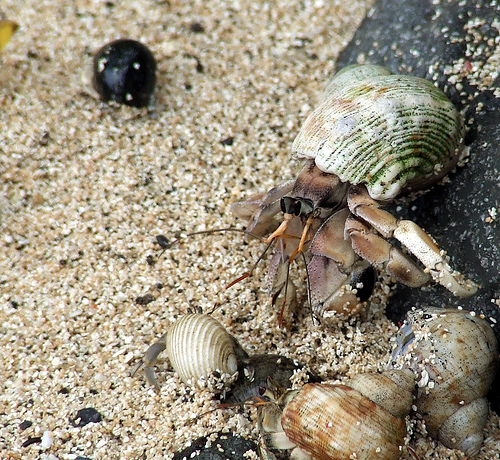Do not hide in a shell like a hermit crab.
- Hermit crabs are a superfamily of 1100 species of crustaceans, and are a type of decapod, a ten legged creature.
- Hermit crabs can be coloured red, orange, yellow, white, brown, blue, pink or green, and have abdomens that are soft and tender and usually shaped as a spiral.
- Hermit crabs typically carry an abandoned shell, that they use to protect their abdomens and withdraw into when they wish to hide from predators.
- Hermit crabs have a lifespan of between 1 to 10 years in the wild, and some species do not live in shells, but instead in structures of other organisms such as coral.
- When hermit crabs grow larger they need to replace their shell, which can become dangerously competitive when there is limited number of vacant shells.
Hermit Crab
Image courtesy of Tim Parkison/Flickr
- Hermit crabs are generally found in salt water habitats, in a range of depths, worldwide, and are most commonly found on coastlines, although approximately 16 species live on land.
- Hermit crabs have the scientific name Paguroidea, and as such, are not close relatives to crabs as they belong to a different infraorder, and for this reason they are not true crabs.
- Hermit crabs, although not limited to, range from 2 to 10 centimetres (0.8 to 4 inches) in length and weigh 200 to 500 grams (7 to 18 ounces), and the females can have 200 eggs at one time, that hatch into the sea.
- Terrestrial (land dwelling) hermit crabs are often kept as pets, and live for a few months to a few decades.
- Hermit crabs’ diet mainly consists of small fish, plankton and worms, while they are preyed on by fish, sharks, octopuses, and other sea creatures.
Bibliography:
Hermit Crab, 2013, A-Z Animals, http://a-z-animals.com/animals/hermit-crab/
Hermit Crab, 2014, Wikipedia, http://en.wikipedia.org/wiki/Hermit_crab






